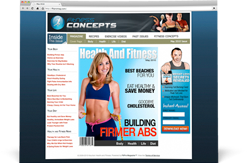When I talk to people about marketing a personal training business, I get a lot of nuts-and-bolts questions about where to market, how many posts to put on Facebook, how to get more followers and so on. Those nuts and bolts questions are important, but the principles of effective marketing come first and you have to have them firmly in your mind before you do any of the nuts and bolts.
Here are what I consider to be the four most important things to keep in mind in order to create your marketing plan and then maximize its potential.
You are selling outcomes, not products
At least nine out of ten personal trainers in your area are competing on price and features (like the latest fitness fads or on-site child care) and their marketing reflects that. YOU need to be in the business of selling outcomes and your marketing should reflect that.
When you focus your marketing on what you can help your clients achieve (and what you are helping your current clients achieve), you take yourself out of all of that competition and set yourself apart. People like on-site child care and they like knowing that the latest fitness fad is available and they’re willing to pay rock-bottom prices for it when rock-bottom prices are offered.
But you’re offering results and people are willing to pay much more for those. So focus on what you and only you can deliver to your clients and then use plenty of social proof in your marketing. (more…)
When a brand-new Fit Body Boot Camp owner or any new fitness entrepreneur is struggling to pay the bills and wondering what to do next to build their business, they have some trouble believing they could be earning six or even seven figures within just a few years. They know very little about marketing a personal training business, becoming well-known in their communities or establishing themselves as experts.
But let’s be really clear about something: the biggest earners at Fit Body Boot Camp started from exactly that same place. If they can get from where you are to where they are, so can you.
 I’ve spent a lot of time talking to and learning from people like Shawna Kaminski, Rebecca Tabbert, Sean Francis, Josh Carter and many other Fit Body Boot Camp owners who are pulling in 6-7 figures per year.
I’ve spent a lot of time talking to and learning from people like Shawna Kaminski, Rebecca Tabbert, Sean Francis, Josh Carter and many other Fit Body Boot Camp owners who are pulling in 6-7 figures per year.
I want to share with you four things they all have know, use and tell the people who ask them for advice; four things that will help you get into a position to start marketing your personal training business into a seven-figure monopoly on the personal training market in your area.
Don’t run your business (or let it run you); use really good systems and let those systems run the business for you.
Fit Body Boot Camp owners have the advantage of having turnkey marketing, email, accounting, staffing and retention systems built right into their start-up package. These systems were chosen because they work. FBBC owners they don’t have to reinvent the wheel or spend hours out of every day overseeing every aspect of the business. Smart entrepreneurs will find out which systems are working for the most people and implement those systems so that they can focus their energy and time on getting and keeping new clients. (more…)
Do you know what the difference is between selling a product and selling a result? The answer is: everything.
When you’re selling a product, you’re just one of many in your area selling the same thing. You have to tell your prospect, “Look, here’s how I compare on price, features, etc.” When you’re selling results, all you have to say is “Look.” The key to fantastic conversion rates and steadily increasing your business and your income is to stop selling personal training and start selling results.
How do you do that?
First, by promising what no one else can and then delivering on that promise. You have what you need to do that. There is no better fat-burning program out there than what is offered by Fit Body Boot Camp and we’re known for it all over the US and Canada. Our fitness boot camps are also known for their community, accountability and support.
All you have to do is deliver a great customer experience using the formula you already have in your hands. When you do, you will have a building full of people who are walking, talking, breathing illustrations of the results you promise and deliver.
Those living, breathing illustrations are going to tell everyone they know how they were able to transform their bodies and their lives and THAT is what will make you stand out among everyone else in your area.
There are a number of different marketing applications of Pereto’s 80/20 rule, but one of them is that 80% of your business will come from just 20% of your marketing channels. And I will tell you straight up that one funnel of your 20% will ALWAYS be referrals. This is why you must be focused on delivering results and then selling those results.
Selling personal training is one thing. Selling a changed body, a changed life, a changed outlook…..that’s a completely different thing and its value is so far above a package of workout sessions that the two can’t even be compared.
This is why the people who make six or seven figures in this business are the ones who can charge based on the value of their services rather than the going rates at the big box gyms or the specials over at the fitness boot camp three blocks away.
They don’t compete on price because they don’t have to. They’re delivering results and they know that results are the real product. Selling personal training is about selling change. It’s about selling true, lasting change and how that lasting change will make the client feel. (more…)
I’ll bet at least a few of you are thinking, “Hey, none of my workouts could ever be called ‘relaxing’.” But that’s not where I’m headed.
Many people make the mistake of thinking that selling personal training is all about pointing out all of the great features and services you offer: lots of session times, low prices, early and late hours, or convenient location.
But that’s not why people buy personal training and 99% of the time, it’s not what makes them choose one fitness boot camp over another. It’s also not why people buy a particular vacation.
People choose a vacation because of two things: the results they want (where the vacation will take them) and the way it will make them feel.
 People choose a personal trainer for the same reasons. If you’re trying to close someone based on anything else, you’ll most likely fail.
People choose a personal trainer for the same reasons. If you’re trying to close someone based on anything else, you’ll most likely fail.
Think about some of the things a good vacation does for you:
It gets you somewhere (helps you reach a goal).
It helps you to get away from your everyday world and its to-do lists.
You meet new people you would not have met otherwise, who make you feel like you’re among friends. (more…)
I’m sure you’ve heard the expression that a bird in the hand is worth two in the bush. But how many of you can look over the last couple of months and admit that you’ve spent more time wooing possible, potential new clients than you have wooing the ones that have signed up for your latest body transformation challenge? How many of you spend all your time after a session trying to sell personal training to the people that came in for a free session and almost no time at all interacting with the ones who are on their second week of a challenge? In other words, you set down the bird in your hand so you could reach for the two in the bushes.
I’m not coming down on you for it; it’s understandable that you’re so focused on bringing more people through the door that you lose sight of the ones that are already there. It’s a natural mistake to hope that the results of your transformation challenge or four-week special will somehow automatically result in those people signing up for six months or a year of training. But if you see yourself and your interactions in this scenario, then I’m betting your retention rate from those challenges and limited-time offers is much lower than it could or should be.
 When you stop “romancing” your clients, the trainer around the corner starts looking really good. Even if your training is getting the results, they’ll eventually go somewhere they feel valued. I promise you that if you don’t deliver a sense of community and actual relationship, most of the people your marketing brings in will be gone before you know it. This leaves you having to reinvent the wheel every few weeks or months because you’re constantly trying to replenish your membership.
When you stop “romancing” your clients, the trainer around the corner starts looking really good. Even if your training is getting the results, they’ll eventually go somewhere they feel valued. I promise you that if you don’t deliver a sense of community and actual relationship, most of the people your marketing brings in will be gone before you know it. This leaves you having to reinvent the wheel every few weeks or months because you’re constantly trying to replenish your membership.
So how do you sell personal training in such a way that the retention factor is practically automatic?
Here’s a blueprint for turning that transformation challenge or low-barrier offer customer into a long-term client:
Make sure the customer is acknowledged and welcomed every time they walk in the door. Nothing is quite as alienating as walking into a group setting and feeling invisible. A smile from the person working out next to them isn’t enough. A wave from the trainer from across the room isn’t enough. Make sure that you or the trainer welcomes each and every customer.
Whenever possible, also try to make sure that one of you speaks with the customer after the session as well. Ask them how they’re doing, how the class was is there anything you can go over with them one-on-one.
Give special gifts and treats to the customer. Welcome them on their first day with a goodie bag full of stuff like water bottles, recipe cards, hand towels, supplement samples, anything you like. Every week or so give them a small token of your appreciation and their progress, such as a gift card for a smoothie or a free fat loss report you’ve written. This is one of the least expensive tools there is. When they fill out your questionnaire, make to put their birthday on your office calendar so that you can give them a card signed by the staff and can acknowledge their special day.
 Keep in touch. One of the fastest tracks to dropping out is when a customer misses a couple of workouts and no one bothers to check on them. All of that talk you spouted about community and family and working together flies out the window. If someone misses more than one session, make sure you or one of your trainers calls to see if they’re okay. And use that call to get them back in the door. They might have a reason completely unrelated to you for missing a couple of sessions, but if they miss any more, there’s a good chance they’ll either lose their momentum (and drop out).
Keep in touch. One of the fastest tracks to dropping out is when a customer misses a couple of workouts and no one bothers to check on them. All of that talk you spouted about community and family and working together flies out the window. If someone misses more than one session, make sure you or one of your trainers calls to see if they’re okay. And use that call to get them back in the door. They might have a reason completely unrelated to you for missing a couple of sessions, but if they miss any more, there’s a good chance they’ll either lose their momentum (and drop out).
If they’ve been going into work early and couldn’t make their early morning sessions, invite them to come to your 7PM workout. If their boyfriend/girlfriend just dumped them, encourage them to come to a session later that day to work it off or just hang out and have a few laughs. If they’re too sore to work out, explain that you can easily modify their moves or weights so that they can ease into it a bit more slowly.
When you deliver a sense of community and of belonging to your low-barrier offer guests, you make it so much easier to sell them one of your long-term training programs. Not only will they want to keep getting results, but they’ll want to remain a part of the community you’ve built for them.
When you’re in the personal training business, you really have to sell yourself. The competition is fierce and it’s a fact that many people choose a trainer randomly. Maybe you’re the number one spot on Google, or it could be that they saw your sign in a tanning salon. Regardless of WHERE they saw you, the point is that you were visible. I firmly believe that you shouldn’t limit yourself to just one means of advertising; have many different balls in the air at any given time. Though there are a million different ways to get your name out there, here are my top 6 tips to selling personal training.
1. Use the referral system – When you sign up clients, require that they provide at least 5 referrals on your personal data sheet when they’re doing their paperwork. You can even take this a step further by offering an incentive to anybody that actually brings you another client. Offer a free training session and praise them generously in front of your other clients when they bring a guest.

2. Network with other businesses – Local tanning salons, hair salons, sporting goods stores, nail salons, daycares, clothing shops, nutrition shops and chiropractors are all great places to target when selling personal training because that’s where your clients frequent. Offer a few free sessions to the employees in exchange for letting you hang your fliers or leave your business cards. Many places will let you leave your cards for free, but if you offer a free session to the employees, you may just turn them into paying clients, too.
3. Build a killer website – We live in a world where people choose everything from their restaurants to their doctors on their mobile devices. If you don’t have a web presence, you’re missing out on a huge percentage of clients. Be sure to do some keyword research and optimize your content with those keywords so that you rank as high as possible. Use plenty of client testimonials, strong headlines and engaging content that really showcases what makes you the best. This is no time to be humble. Put yourself out there and sell yourself!
4. Offer Smaller, Specific Classes – Advertise classes of short duration such as a “2 weeks to flatter abs” class, a “21 day fat burning” class, or something else that’s popular in your area. Really put your best foot forward during these sessions by being friendly, passionate and enthusiastic. Show an interest in the personal success of each client and be available for questions before and after class. Don’t be afraid to promote yourself a bit; after all, selling personal training sessions is your marketing goal here. (more…)
Guest Post by Cody Sipe, PhD
Training mature adults effectively is about more than just meeting their physical needs. If you want to grow your business with this gigantic market then it is critical that you understand who they are. What makes them tick. What appeals to them. What repels them. What they respond to. What characteristics they look for in a facility or in a trainer.
Getting them to train with you involves more than just having a personal training certification, creating a slick flyer, having a great name or tagline, or giving a big discount. Like with any other target market you’ve got to be inside their heads. Most importantly it is vital that you understand, appreciate and then appeal to their core values. If you want their business you need to earn their business.
Here are some key values that you can use to appeal to potential mature clients:
Family

Mature adults love their family. They want to be able to spend lots of quality time with them. They worship together, eat together and play together. The Boomers are often called the “sandwich generation” because they end up caring for their aging parents and supporting their adult kids and/or grandkids at the same time.
In fact, a large percentage of them financially support their adult children. Those that are grandparents are especially fond of their grandchildren. Grandkids are the apple of their eye. They would do almost anything for them. And they would do almost anything to be able to spend time with them.
You want to appeal to mature adults then appeal to their sense of family. Tell them how your program will help them to play with their grandchildren, explore Disneyworld with them and climb the bleachers at their sports competitions. Show images of families and grandchildren spending time together. Talk to your current clients about their families and grandchildren. Give them an opportunity to brag a little. Have times or events where they can bring their families to the facility so they can see where “grandma” and “grandpa” work out.
Socialization
This might seem obvious but it is important to both recognize and utilize this fact. We use small group personal training because it provides a great avenue for socialization. Clients that exercise together in groups of 4-6 develop great relationships. The group provides great support to one another and helps them to stay accountable for exercise. It can be challenging, at times, to corral the conversation and keep everyone exercising but they have a great time and the session flies by quickly.
Highlight the relationships that exist between members in your facility. When they come to check out your facility introduce them to some of the other clients. Highlight your clients in your blog emphasizing your relationship with them. Communicate how your program can help them stay socially connected.
Spirituality and Faith
As people get older and travel through mid-life their spiritual and religious beliefs typically deepen and become more meaningful. Faith becomes even more important than in their younger years. Whether or not you have a deep faith or not doesn’t matter. A large majority of mature adults do. Sometimes what you don’t do is just as important as what you do. (more…)
Guest Post by Cody Sipe, PhD
Almost all mature clients need to include training for balance and core stability in order to improve activities of daily living, reduce risk of injury and prevent falls. There are many ways to train these specific areas, and you should learn some of them if you want to know how to be a personal trainer that is well rounded. One method that is effective yet seldom used is perturbation training.
Reactive and Proactive Postural Control
Postural control is by definition the ability to control the body’s position in space in order to control the center of mass relative to the base of support and to maintain the appropriate relationships between the body and the environment. There are two basic types of postural control: reactive and proactive. Reactive postural control is the ability to recover after an unexpected perturbation (i.e. push, pull, shove, slip, trip, etc.).

For example, when a person is bumped unexpectedly from behind they must react to the perturbation quickly and appropriately if they are to remain upright. If the bump is strong enough then it might also require the person to take a compensatory step in order to keep from falling.
Proactive (or anticipatory) postural control is the ability to modify postural control before a perturbation occurs in order to maintain stability. In essence, the person knows the perturbation is coming and reacts in order to be able to keep from being destabilized by the perturbation. For example, when a person sees that a person is about to bump into them then they change their posture accordingly. Typically this means that they lower their center of mass, lean in the direction of the coming perturbation and tighten their core musculature.
Both reactive and proactive postural control is important to train because while there is definite overlap between the two there are also distinct differences. Reactive postural control relies heavily on somatosensory information coming from touch and proprioception. Perturbations that are unexpected turn on proprioceptors to a much greater degree than perturbations that are expected. However, how quickly that information is processed and then turned into appropriate compensatory muscle activation varies.
The point of training older clients using perturbations that are unexpected is to teach their nervous system how to react quickly and effectively when their postural control is challenged. Individuals that cannot react quickly and appropriately will lose their balance because their center of mass will get pushed outside of their base of support or will cause their spine to flex. This increases the chance that they will trip, fall or become injured.
Proactive postural control relies heavily on visual information to estimate the force parameters such as direction and magnitude in order to scale an appropriate response. When a person sees that, for example, a person is about to bump into them they quickly determine how to change their posture or take an evasive action in order to either absorb or avoid the perturbation. Experience in similar situations helps the individual to determine what kind of response to make.
Multiplanar Core Stability
It is the primary purpose of the core musculature to stabilize the spine and keep it in neutral position during human movement – activities of daily living, recreational activities, sports, work tasks, etc. This requires counteracting forces in the sagittal, frontal and transverse planes…and many times multiple planes simultaneously. Sometimes this is unexpected and sometimes it is expected thus the need for including perturbations that challenge both reactive and proactive postural control. (more…)
If you work hard as a personal trainer, it’s only natural to want to start up your own personal training business. Lots of successful fitness professionals started out on this path… working in a big box gym, slowly picking up clients here and there, then building up a big enough client base to venture out on their own.
But when it comes to growing a personal training business, and making it a huge success, a lot of personal trainers end up struggling because they lack the marketing experience they need to get people interested in their services. Marketing is vital for growing any business, whether it’s brand new or has been established for a while, but most new fitness business owners seem to gloss over this important step.
Marketing a personal training business doesn’t have to be that complicated or even that expensive if you have a few tricks up your sleeve. If you’re new to the biz, then don’t worry… there are plenty of resources out there to help you become a marketing master and business owner, a lot of which are right here on this blog.
So, here are a couple of simple ways you can market a personal training business without spending an arm and a leg.

Social Media Marketing - Facebook
If you don’t have an official Facebook page for your business, then now is the time to start one. And don’t just use your personal Facebook profile to get the word out, start a new page for your business only. You want your business page to be as professional as possible, so mixing your personal account with your business one is definitely a bad idea. The goal of your marketing plan should be to get as many people in your community talking about your personal training business as you can, so you’re allowed to be a bit controversial, but aim to engage people so that you can build up a little buzz around your services. Make it a point to answer any questions that come your way and to interact with your fans on a regular basis to get a feel for what people in your area want.
Once you build up a little following, you can use Facebook as a source for topics to use in your email marketing campaign. Always get permission if you’re using someone’s name or what have you, but you can use an interesting topic that comes up and incorporate them into your website or email blasts. Most people love to see that they sparked a conversation and will probably share your email/promotion/or story, which will help to increase your number of fans.
Social Media Marketing – YouTube
Youtube is a powerful marketing tool that a lot of personal trainers seem to shy away from. Whether you’re comfortable on camera or not, you should try to make videos about your personal training business and put them up on Youtube. Marketing this way is very effective and super easy, not to mention cheaper than buying radio or air time.
Get your videos to work for you by using Google’s free Keyword Tool to research what people are searching for in your area in terms of personal training or weight loss. Marketing a personal training business through sites like Youtube is a great way to get yourself in front of your local audience. There are over a million searches every month for things like “personal fitness training” and a lot of these are localized searches that you could be taking advantage of.
Take some of those keywords and use it to name your videos and for writing up your video description as well as in the headlines and content of articles that you’re writing (start a blog for your business if you haven’t already). You can then share this video all your friends and family, your current clients, you can post it on your website, and start using it as a tool to describe what you do. (more…)

 I’ve spent a lot of time talking to and learning from people like Shawna Kaminski, Rebecca Tabbert, Sean Francis, Josh Carter and many other
I’ve spent a lot of time talking to and learning from people like Shawna Kaminski, Rebecca Tabbert, Sean Francis, Josh Carter and many other 
 People choose a personal trainer for the same reasons. If you’re trying to close someone based on anything else, you’ll most likely fail.
People choose a personal trainer for the same reasons. If you’re trying to close someone based on anything else, you’ll most likely fail. When you stop “romancing” your clients, the trainer around the corner starts looking really good. Even if your training is getting the results, they’ll eventually go somewhere they feel valued. I promise you that if you don’t deliver a sense of community and actual relationship, most of the people your marketing brings in will be gone before you know it. This leaves you having to reinvent the wheel every few weeks or months because you’re constantly trying to replenish your membership.
When you stop “romancing” your clients, the trainer around the corner starts looking really good. Even if your training is getting the results, they’ll eventually go somewhere they feel valued. I promise you that if you don’t deliver a sense of community and actual relationship, most of the people your marketing brings in will be gone before you know it. This leaves you having to reinvent the wheel every few weeks or months because you’re constantly trying to replenish your membership. Keep in touch. One of the fastest tracks to dropping out is when a customer misses a couple of workouts and no one bothers to check on them. All of that talk you spouted about community and family and working together flies out the window. If someone misses more than one session, make sure you or one of your trainers calls to see if they’re okay. And use that call to get them back in the door. They might have a reason completely unrelated to you for missing a couple of sessions, but if they miss any more, there’s a good chance they’ll either lose their momentum (and drop out).
Keep in touch. One of the fastest tracks to dropping out is when a customer misses a couple of workouts and no one bothers to check on them. All of that talk you spouted about community and family and working together flies out the window. If someone misses more than one session, make sure you or one of your trainers calls to see if they’re okay. And use that call to get them back in the door. They might have a reason completely unrelated to you for missing a couple of sessions, but if they miss any more, there’s a good chance they’ll either lose their momentum (and drop out).





